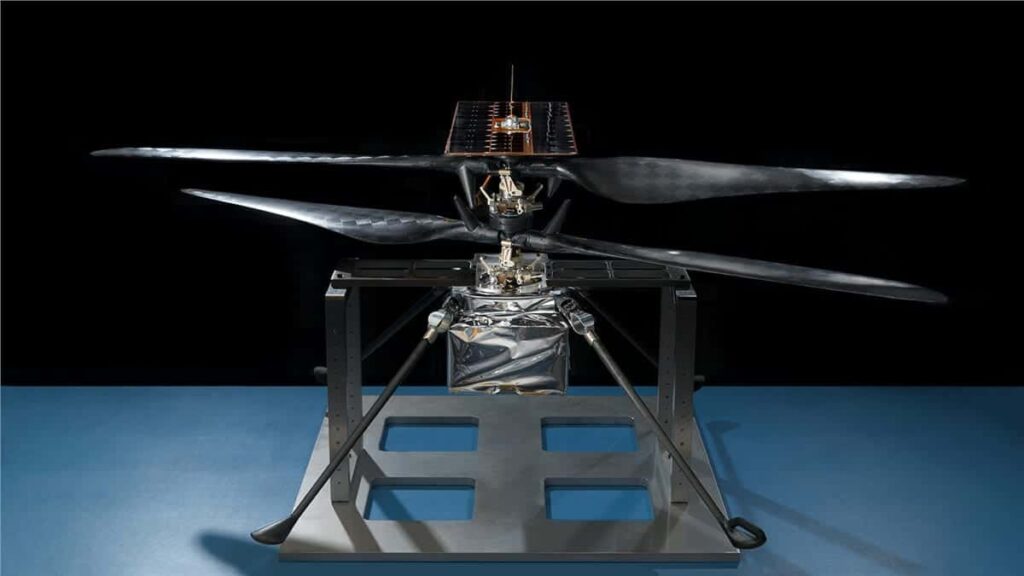NASA has announced that its autonomous Mars Helicopter flight demonstration project has passed a number of key tests and moved into the final testing phase. In 2021, the small, autonomous helicopter will be the first vehicle in history to attempt to establish the viability of heavier-than-air vehicles flying on another planet.
“Nobody’s built a Mars Helicopter before, so we are continuously entering new territory,” said MiMi Aung, project manager for the Mars Helicopter at NASA’s Jet Propulsion Laboratory in Pasadena, California. “Our flight model — the actual vehicle that will travel to Mars — has recently passed several important tests.”
The team has previously operated the flight model in a simulated Martian environment. The helicopter was moved to Lockheed Martin Space in Denver for compatibility testing with the Mars Helicopter Delivery System, which will hold the 4-pound (1.8-kilogram) spacecraft against the belly of the Mars 2020 rover during launch and interplanetary cruise before deploying it onto the surface of Mars after landing.
As a technology demonstrator, the Mars Helicopter carries no science instruments. Its purpose is to confirm that powered flight in the tenuous Martian atmosphere (which has 1% the density of Earth’s) is possible and that it can be controlled from Earth over large interplanetary distances. The helicopter also carries a camera capable of providing high-resolution color images to further demonstrate the vehicle’s potential for documenting the Red Planet.
Future Mars missions could enlist second-generation helicopters to add an aerial dimension to their explorations. They could investigate previously unvisited or difficult-to-reach destinations such as cliffs, caves and deep craters, act as scouts for human crews or carry small payloads from one location to another. But before any of that happens, a test vehicle has to prove it is possible.
In Denver, the Mars Helicopter and its delivery system were checked to make sure that the electrical connections and mechanisms that linked the flight vehicle with its cradle fit snuggly. Then, while still mated, the duo endured the sorts of vibrations they will experience during launch and in-flight operations. The thermal vacuum portion of the testing introduced them to the kinds of extreme temperatures (down to -200 degrees Fahrenheit, or -129 degrees Celsius) that they will encounter in space and on Mars and that could cause components to malfunction or fail.
The Mars Helicopter returned to JPL for further testing and finishing touches. Among the highlights: A new solar panel that will power the helicopter has been installed, and the vehicle’s rotor blades have been spun up to ensure that the more than 1,500 individual pieces of carbon fiber, flight-grade aluminum, silicon, copper, foil and aerogel continue to work as a cohesive unit.
“We expect to complete our final tests and refinements and deliver the helicopter to the High Bay 1 clean room for integration with the rover sometime this summer,” said Aung, “but we will never really be done with testing the helicopter until we fly at Mars.”
The Mars Helicopter will launch with the Mars 2020 rover on a United Launch Alliance Atlas V rocket in July 2020 from Space Launch Complex 41 at Cape Canaveral Air Force Station, Florida. When it lands in Jezero Crater on Feb. 18, 2021, the rover will also be the first spacecraft in the history of planetary exploration with the ability to accurately retarget its point of touchdown during the landing sequence.
The 2020 rover will conduct geological assessments of its landing site on Mars, determine the habitability of the environment, search for signs of ancient Martian life and assess natural resources and hazards for future human explorers. In another first, scientists will use the instruments aboard the rover to identify and collect samples of rock and soil, encase them in sealed tubes, and leave them on the planet’s surface for potential return to Earth on a future Mars mission.
JPL is building and will manage operations of the Mars 2020 rover and Mars Helicopter for the NASA Science Mission Directorate at the agency’s headquarters in Washington. NASA’s Launch Services Program, based at the agency’s Kennedy Space Center in Florida, is responsible for launch management.



















